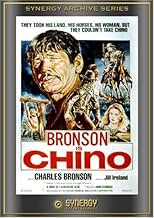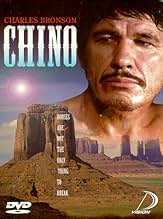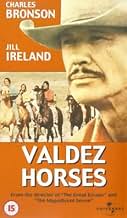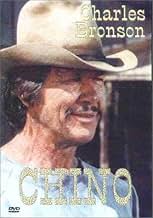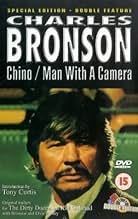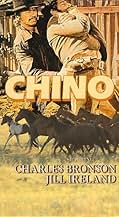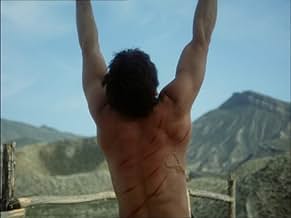VALUTAZIONE IMDb
6,0/10
3023
LA TUA VALUTAZIONE
Un adolescente in fuga e un allevatore di cavalli di razza mista stringono un'improbabile amicizia nel contesto di difficoltà comuni.Un adolescente in fuga e un allevatore di cavalli di razza mista stringono un'improbabile amicizia nel contesto di difficoltà comuni.Un adolescente in fuga e un allevatore di cavalli di razza mista stringono un'improbabile amicizia nel contesto di difficoltà comuni.
- Regia
- Sceneggiatura
- Star
José Nieto
- Mexican
- (as Jose Nieto)
Diana Lorys
- Mexican
- (scene tagliate)
- (as Diana Loris)
Conchita Muñoz
- Mexican
- (as Conchita Munoz)
Henri Bidon
- Cowboy
- (as Henri Bidon Mikaleffs)
Florencio Amarilla
- Little Bear
- (non citato nei titoli originali)
Annamaria Clementi
- Native American Girl
- (non citato nei titoli originali)
Enrique García Santiago
- Chino's Attacker
- (non citato nei titoli originali)
Eduardo García
- Chino's Attacker
- (non citato nei titoli originali)
Recensioni in evidenza
I agree that the change of directors caused a change in quality of the film, but all in all this is one of my favorite westerns. It is thought provoking and realistic. Bronson's acting comes off as natural and he understood who Chino was. His relationship with the young boy seems odd, but not forced. The scenes with Jill Ireland are amusing and show the difference in culture between Europe and the old west. Filmed in Europe, there are a few quirks that sort of make you laugh, the Native Americans and the town seem a little hokey, but the film remains enjoyable. The ending bothered me, but thats what made this a good film. I reccommend this to anyone who wants to sit and relax to a good western.
...with some touching moments. From the title you wouldn't expect much, but I liked this film a lot and wonder why it is almost never aired on TV. Bronson and Van Patten have a great chemistry and their on-screen relationship is very believable. The story is simple, with an interesting beginning and a good, plausible ending. The soundtrack is nice, too.
The only thing I would change in this film is to make it longer, add more scenes so we can get to know the characters in various settings, and delve into the background to the conflict between Chino and his neighbors.
I recommend this film, especially to fans of Charles Bronson. I will definitely watch this film again (finally saw it for the first time, after all these years!).
The only thing I would change in this film is to make it longer, add more scenes so we can get to know the characters in various settings, and delve into the background to the conflict between Chino and his neighbors.
I recommend this film, especially to fans of Charles Bronson. I will definitely watch this film again (finally saw it for the first time, after all these years!).
Chino is the story of the typical loner who doesn't fit into society. Typical Bronson film with an un-typical Bronson ending. Bronson plays Chino who breaks and sells wild horses. After taking a young boy in as a ranch hand things start to get better for Chino. He falls in love with a rancher's sister and things deteriorate from that point. Can recommend this film for Bronson fans.
"Chino" had such potential. It was directed (partially) by the great John Sturges and its star, Charles Bronson, gives a wonderful performance, exuding the kind of quiet masculine strength that no one in Hollywood has these days. Most of the complaints about the film have to do with its atypically downbeat ending. I won't spoil it for you, but I will say that I thought the ending, though viscerally unsatisfying, was intellectually and emotionally appropriate, more along the lines of something you'd read in a novel than see in a pop movie.
But what really goofs the film up is the see-saw realism brought about by being directed by two different men, the ailing Hollywood icon Sturges, and Duilio Coletti, unknown in the states, who may have been even further down the slope of his career in Europe. Formalist Sturges strove for at least the inner-logic of "movie reality." Coletti's work had devolved into the worst of sloppy Eurowesterns.
Parts of the film seem to strive for realism, using natural lighting effects, etc. But as the film progresses, more and more glaring anachronisms pop up, such as perfectly square hay bales, only possible with baling machines. This break with even a third-grader's knowledge of the old west reaches its zenith when a character burns down a house, using a PLASTIC JUG of kerosene. A PLASTIC JUG in the old west! Hard to believe that even a European wouldn't know that there was no plastic in those days. I don't know what the circumstances were behind Sturges either quitting or being fired from the director's chair part-way through the filming of "Chino," but it certainly seems as though the scenes he left missing were shot by Coletti as quickly and with as little thought as possible.
The film is also hobbled a bit by it's international origins. The villian is obviously French while his sister, played by Jill Ireland, is obviously British. Ireland has a brief bit of dialoge explaining this, but it only leaves you scratching your head all the more. Otherwise, "Chino" has many wonderful segments, thoughtful and well-acted.
As a postscript: I wish someone would restore this and other of Bronson's more unusual Euro flicks and make them available on high quality widescreen dvd. The currently available vhs and dvd versions of Chino, Red Sun, Honor Among Theives, Cold Sweat, You Can't Win 'Em All, and etc, all suck bigtime. MGM? Anchor Bay? HELLO?
But what really goofs the film up is the see-saw realism brought about by being directed by two different men, the ailing Hollywood icon Sturges, and Duilio Coletti, unknown in the states, who may have been even further down the slope of his career in Europe. Formalist Sturges strove for at least the inner-logic of "movie reality." Coletti's work had devolved into the worst of sloppy Eurowesterns.
Parts of the film seem to strive for realism, using natural lighting effects, etc. But as the film progresses, more and more glaring anachronisms pop up, such as perfectly square hay bales, only possible with baling machines. This break with even a third-grader's knowledge of the old west reaches its zenith when a character burns down a house, using a PLASTIC JUG of kerosene. A PLASTIC JUG in the old west! Hard to believe that even a European wouldn't know that there was no plastic in those days. I don't know what the circumstances were behind Sturges either quitting or being fired from the director's chair part-way through the filming of "Chino," but it certainly seems as though the scenes he left missing were shot by Coletti as quickly and with as little thought as possible.
The film is also hobbled a bit by it's international origins. The villian is obviously French while his sister, played by Jill Ireland, is obviously British. Ireland has a brief bit of dialoge explaining this, but it only leaves you scratching your head all the more. Otherwise, "Chino" has many wonderful segments, thoughtful and well-acted.
As a postscript: I wish someone would restore this and other of Bronson's more unusual Euro flicks and make them available on high quality widescreen dvd. The currently available vhs and dvd versions of Chino, Red Sun, Honor Among Theives, Cold Sweat, You Can't Win 'Em All, and etc, all suck bigtime. MGM? Anchor Bay? HELLO?
This Italian/Spanish/French co-production concerns a mestizo , Chino Valdez (Bronson at fifty-one years of age), the Halfbreed , he's a horse breeder rancher who struggles to maintain his way of life by facing off foes. 'The Valdez Horses' refers to Chino's equine herd . The half-Indian man lives solitary until the arrival a young (Vincent Van Patten) . Chino decides to take him in and teach him the art of rodeo , raising , breeding and round-up horses . The movie follows the Bronson's adventures and his imposing black stallion that represents freedom and proud what the white men impede him to enjoy. Meanwhile , Chino has a sensitive romance, as he falls in love with the sister (Jill Ireland) of a wealthy owner (Marcel Bozzuffi) who doesn't approve the relationship and taking the subsequent vengeance. Bronson is Valdez!...and around Valdez things erupt. They Took His Land... His Horses... His Woman... But... They Couldn't Take Chino!
It is a Spaghetti Western shot in Almeria (Spain) where by that time lots of Maccaroni/Paella Westerns were shot , and its source 'The Valdez Horses' , a novel written by Lee Hoffman (published in 1967) ; but being a little bit boring and slow-moving , although there are some shootouts, action , and excitement enough. It even turns out to be quite advanced for its time, due to its ecological content, being an ode to the land and wild animals; its political correctness in the treatment of the Indians is also worthy of praise.
Interesting storyline though monotonous and tiring , at times, by Clair Huffaker , he was a prestigious screenwriter who wrote several notorious westerns. Clair Huffaker is credited as the sole writer on American prints , though in the Italian ones is also signed by Massimo De Rita and Arduino Maiuri . There's a brief exploring about Native American Indians and dream sequences that tend to undermine the easy action. As usual, Charles Bronson is a convincingly silent tough guy, here playing Chino Valdez, a mix of Native American Indian/white European ancestry, a horse breeder who domesticates and trains horses ; while Jill Ireland (Bronson's real wife) , as his sweetheart , is enjoyable and enticing . This film is one of Charles Bronson's 70s westerns , his westerns made during the seventies include Red sun (1971) by Terence Young , Chato (1972) by Michael Winner , From noon till three (1976) by Frank D Gilroy , Nevada Express (1975) by Tom Gries and White Buffalo (1977) by J. Lee Thompson , being most of them produced by Dino De Laurentiis. Spectacular outdoors well shown by cameramen Armando Nannuzzi and Godofredo Pacheco. Set in New Mexico , USA , this movie was actually filmed in Almería , desert of Tabernas , Andalucía , Spain . Musical score by Guido and Maurizio De Angelis is effective, stirring and evocative , they are composers of numerous spaghetti western soundtracks .
Weak though slick direction by John Sturges, he previously made classic westerns as ¨Gunfight OK Corral¨, ¨Last train from Gun Hill¨ and ¨The magnificent seven¨ and his former Western film had been ¨Joe Kidd¨ with Clint Eastwood . Being fifth and ending film that filmmaker Sturges made with star Charles Bronson . This Italian/Spanish/French co-production was premiered in Europe in 1973 but didn't open in the USA until 1976. In the Italian version appears credited as co-director Duilio Coletti. Duilio was a good craftsman who mainly filmed adventure genre such as ¨Captain Fracassa¨, ¨Il Fornaretto Di Venezia¨, The Mask of Cesare Borgia" , "Merchant of Slaves" and wartime genre , such as ¨Anzio¨ co-directed by Edward Dymitryck , ¨Divisione Folgore¨, "The Earth Cries Out" , "Hell Raiders of the Deep" , and ¨Under ten flags¨ . The motion picture is a Charles Bronson vehicle along with his wife, Jill Ireland , both of whom sadly deceased . Despite having little fame in the past, and having been somewhat hidden and obscure, the film has improved over time, thanks above all to recent remasterings, compared to old, poorly worn prints from a 'public domain', and is today better regarded, which is why it is highly recommended for lovers of the genre. Rating: 6/10. Acceptable and passable, but not remarkable.
It is a Spaghetti Western shot in Almeria (Spain) where by that time lots of Maccaroni/Paella Westerns were shot , and its source 'The Valdez Horses' , a novel written by Lee Hoffman (published in 1967) ; but being a little bit boring and slow-moving , although there are some shootouts, action , and excitement enough. It even turns out to be quite advanced for its time, due to its ecological content, being an ode to the land and wild animals; its political correctness in the treatment of the Indians is also worthy of praise.
Interesting storyline though monotonous and tiring , at times, by Clair Huffaker , he was a prestigious screenwriter who wrote several notorious westerns. Clair Huffaker is credited as the sole writer on American prints , though in the Italian ones is also signed by Massimo De Rita and Arduino Maiuri . There's a brief exploring about Native American Indians and dream sequences that tend to undermine the easy action. As usual, Charles Bronson is a convincingly silent tough guy, here playing Chino Valdez, a mix of Native American Indian/white European ancestry, a horse breeder who domesticates and trains horses ; while Jill Ireland (Bronson's real wife) , as his sweetheart , is enjoyable and enticing . This film is one of Charles Bronson's 70s westerns , his westerns made during the seventies include Red sun (1971) by Terence Young , Chato (1972) by Michael Winner , From noon till three (1976) by Frank D Gilroy , Nevada Express (1975) by Tom Gries and White Buffalo (1977) by J. Lee Thompson , being most of them produced by Dino De Laurentiis. Spectacular outdoors well shown by cameramen Armando Nannuzzi and Godofredo Pacheco. Set in New Mexico , USA , this movie was actually filmed in Almería , desert of Tabernas , Andalucía , Spain . Musical score by Guido and Maurizio De Angelis is effective, stirring and evocative , they are composers of numerous spaghetti western soundtracks .
Weak though slick direction by John Sturges, he previously made classic westerns as ¨Gunfight OK Corral¨, ¨Last train from Gun Hill¨ and ¨The magnificent seven¨ and his former Western film had been ¨Joe Kidd¨ with Clint Eastwood . Being fifth and ending film that filmmaker Sturges made with star Charles Bronson . This Italian/Spanish/French co-production was premiered in Europe in 1973 but didn't open in the USA until 1976. In the Italian version appears credited as co-director Duilio Coletti. Duilio was a good craftsman who mainly filmed adventure genre such as ¨Captain Fracassa¨, ¨Il Fornaretto Di Venezia¨, The Mask of Cesare Borgia" , "Merchant of Slaves" and wartime genre , such as ¨Anzio¨ co-directed by Edward Dymitryck , ¨Divisione Folgore¨, "The Earth Cries Out" , "Hell Raiders of the Deep" , and ¨Under ten flags¨ . The motion picture is a Charles Bronson vehicle along with his wife, Jill Ireland , both of whom sadly deceased . Despite having little fame in the past, and having been somewhat hidden and obscure, the film has improved over time, thanks above all to recent remasterings, compared to old, poorly worn prints from a 'public domain', and is today better regarded, which is why it is highly recommended for lovers of the genre. Rating: 6/10. Acceptable and passable, but not remarkable.
Lo sapevi?
- QuizFinal western of director John Sturges.
- BlooperIn the early bar fight, one of the stuntmen coming at Chino with a chair tosses his head back a good half second before being hit.
- Citazioni
Chino Valdez: That's the way Indians bury their dead. They'd rather be close to the sun than have dirt thrown in their faces.
- ConnessioniFeatured in Charles Bronson, Hollywood's Lone Wolf (2020)
- Colonne sonoreFreedown rainbow
Composed by Guido De Angelis and Maurizio De Angelis
I più visti
Accedi per valutare e creare un elenco di titoli salvati per ottenere consigli personalizzati
- How long is Chino?Powered by Alexa
Dettagli
Contribuisci a questa pagina
Suggerisci una modifica o aggiungi i contenuti mancanti

Divario superiore
By what name was Valdez il mezzosangue (1973) officially released in India in English?
Rispondi


